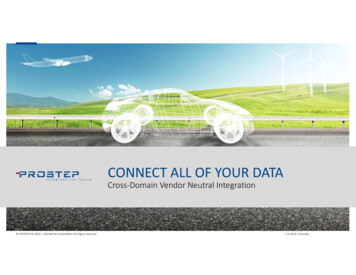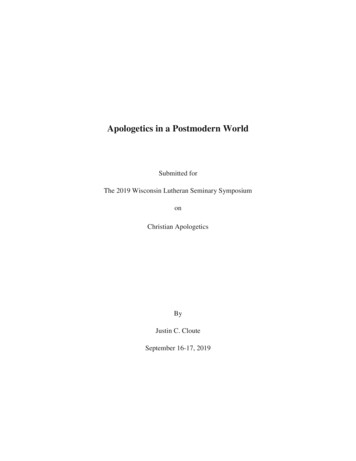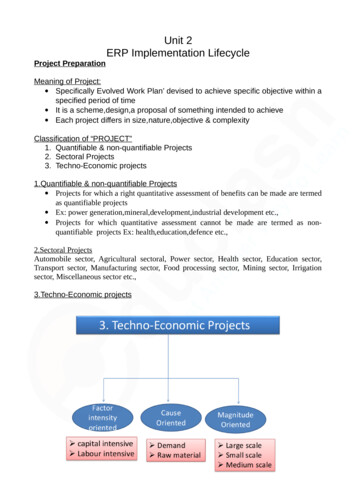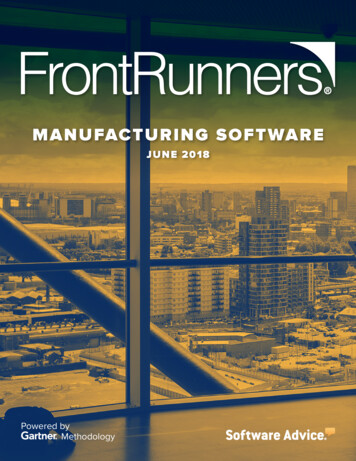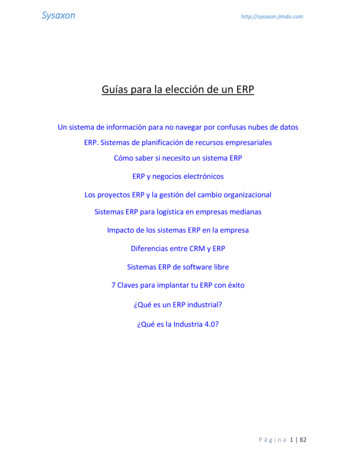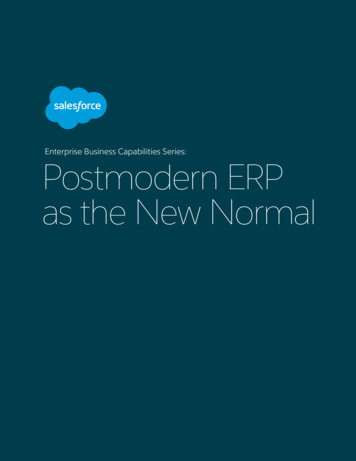
Transcription
Enterprise Business Capabilities Series:Postmodern ERPas the New Normal
Table of ContentsTHE CONTINUUM OF ERP CUSTOMERS . . . . . . . . . . . . . . . . 3THE SALESFORCE POSTMODERN ENTERPRISE APPLICATIONSTRATEGY . . . . . . . . . . . . . . . . . . . . . . . . . . . . . . . . . 4THE SALESFORCE ADVANTAGE–SUPPORT MISSION READINESSAND STREAMLINE ENTERPRISE BUSINESS CAPABILITIES (EBC) . . . 5PAIN POINTS & SOLUTIONS . . . . . . . . . . . . . . . . . . . . . . . 6CASE STUDIES . . . . . . . . . . . . . . . . . . . . . . . . . . . . . . 12HOW DOES MULESOFT SUPPORT YOUR INTEGRATION STRATEGYIN THE POSTMODERN ERP FRAMEWORK? . . . . . . . . . . . . . . 13YOU MAY CALL IT POSTMODERN ERP, ENTERPRISE BUSINESSCAPABILITIES (EBC) OR DIGITAL OPERATING PLATFORM (DOP).NOW HOW DO YOU OPERATIONALIZE IT WITH A CLOUD FIRSTAPPROACH IN MIND? . . . . . . . . . . . . . . . . . . . . . . . . . . 14Postmodern ERPSalesforce 2
The Continuum Of ERP CustomersU.S. government agencies often must make complex decisions based on clean, consistent, and often static data to manage their missions efficiently and effectively. Usually, this data is gathered from multiple sources, and Enterprise ResourcePlanning (ERP) systems are at the center of those processes, encompassing financial, supply chain, and human resourcefunctions.However, agencies are often limited to the functionality provided by these platforms and furthermore these legacysystems have not kept pace with evolving expectations to access information anytime and anywhere. Even newer ERPsystems do not provide a positive experience for users, often requiring them to log into multiple, inconsistent systems orto manually complete transactions, view data, or simply collaborate with stakeholders.Gartner defines Postmodern ERP as “a technology strategy that automates and links administrative and operational business capabilities (such as finance, HR, purchasing, manufacturing and distribution) with appropriate levels of integrationthat balance the benefits of vendor-delivered integration against business flexibility and agility. This definition highlightsthat there are two categories of ERP strategy: administrative and operational.”*This new Postmodern ERP framework is quickly making traditional ERP systems -- historically used to support everyaspect of an agency’s mission -- more efficient and responsive. This change accounts for shifting agency expectationsbrought about by the advent of the internet, smartphones, and unlimited access to information anytime and anywhere.The COVID-19 pandemic has given new meaning to ‘mission readiness’ for government agencies and made a safe, secure, and digitally-oriented workforce even more crucial. As government agencies adapt to the new environment, theymay need to adopt innovative approaches to give employees access to the resources they need to fulfill their duties andachieve mission readiness.Government agencies’ current ERP landscape can be monolithic and inflexible, yielding high costs and long lead timesto make changes or implement new capabilities. Additionally, with the resulting lack of process standardization, agenciescan experience inefficient data management, patched-up data analytics for decision making, and high costs due to adhoc customizations and maintenance.Most government agencies understand that they need to undergo a significant transformation from being product-centric to customer-centric organizations. However, their current processes, tools, and capabilities are often fragmented,over-customized, complex, and unintuitive to use. This outdated landscape can impact their competitiveness, ability toserve their customers in the manner they expect (both internal and external customers), lower overall customer satisfaction levels, and creates operational inefficiencies.Cloud-based platforms such as Salesforce provide the flexibility and functionality agencies need to reflect modern innovation. Salesforce is one of the companies leading the digital transformation from legacy ERP systems that are no longerkeeping pace with modern mission demands.*Source: glossary/postmodern-erpPostmodern ERPSalesforce 3
The Salesforce Postmodern Enterprise Application StrategyGartner’s Pace-Layered Application Strategy is defined as “a methodology for categorizing, selecting, managing and governing applications to support business change, differentiation and innovation.”* Salesforce has assisted many agencieswith wrapping legacy systems with a new layer of agility to help unlock back-office data and jump-start the transformation.The Salesforce Postmodern Enterprise Application StrategyCITIZEN /SERVICE MEMBERPORTALSSINGLE VIEW OFTHE CITIZEN /SERVICE MEMBERMOBILEREADYBUSINESS PROCESSAUTOMATIONEMBEDDEDANALYTICSENGAGEMENT LAYERINTEGRATEDPLATFORMBUSINESS PROCESS LAYEREXPERIENCEAPISPROCESSAPISSERVERLESS With a Salesforce Postmodern ERP multi-tenant platform, agencies and systems integrators are enabled to quickly configure and develop the highly-responsive and modern applications they need while utilizing the ERP system data theyrequire. IT managers can design applications to suit their specific needs using clicks – not code – through the user interface, automated workflows, and analytics that provide compelling, interactive visualizations. The platform also includes avariety of programming language supports so developers can code complex apps spanning multiple business processesand deliver them to various mobile devices.Salesforce capabilities can be deployed rapidly as agencies do not have to procure, install, or maintain servers, storage,networking equipment, security products, or the hardware and software. Agencies can also benefit from a reducedInformation Assurance (IA) burden with the help of Salesforce Government Cloud Plus, which maintains a FedRAMPHigh Provisional-Authority to Operate (ATO), and Salesforce Government Cloud, which maintains a FedRAMP ModerateAgency ATO, along with Department of Defense (DoD) impact level (IL) 4 Provisional Authorizations (PAs).Salesforce has been solving service-centric and operational business processes problems for organizations across multiple industries for more than 20 years. With a leading cloud platform, Salesforce helps free government data from legacysystems and unleashes staff, partners, and citizens to administer the government in powerful new ways. In the publicsector, Salesforce’s trusted cloud platform and applications help government employees and agencies easily collaborateand connect with citizens, service members and partners like never before. Governments around the globe are leveraging Salesforce’s leading cloud solutions and experiencing incredible results ranging from more connected customerservice, to streamlined operations, better performance, and overall cost savings.*Source: rn ERPSalesforce 4
The Salesforce Advantage–Support Mission Readiness andStreamline Enterprise Business Capabilities (EBC)Salesforce is helping governments digitally transform by providing secure, cloud platforms that put their employees andservice members at the center and engage them throughout the transition in ways that drive productivity.The key to streamlining the process without sacrificing the user experience is to separate the user interaction layerfrom the transactional data hub. When you provide a robust user layer (Customer Relationship Management or “CRM”solution) for your processes, you benefit from having a 360-degree view of customers, the users, and all interactions,automating the business life-cycle processes and collaborating with the stakeholders in unique user experience. Transactional records can be stored in the on-prem or cloud-based ERP but made visible in Salesforce through flexible androbust data integration options.Common business drivers behind the use of the Salesforce platform to augment ERP include: making application development efforts more scalable and agile to meet business demand, spending less time delivering and managing infrastructure, and the need for a platform they can build upon and grow their business operations.Salesforce provides a portfolio of services to support and accelerate application development and create systems ofengagement and innovation in concert with ERP applications. The systems tend to be focused on customers - be theyexternal to your agency (citizens, partners, vendors) or internal (employees). The Salesforce platform is built to helpremove the traditional time lags and complexity of delivering these types of solutions in line with modern citizens’expectations.Salesforce supports better business and operational outcomes for organizations by serving as a scalable and agile application development platform. Furthermore, application development efforts are timelier and more productive whenbased on the Salesforce platform.As a result of these efficiencies, government agencies are moving from other development platforms (often associatedwith ERP systems) to the Salesforce platform and have sped up their application development and delivery processes.Furthermore, born-in-the-cloud organizations using Salesforce as a fundamental component of their operational strategies cited agile and fast development cycles as a core benefit.By integrating Salesforce’s capabilities, government agencies can streamline their operations by implementing mobilecase management, intelligent queuing, dynamic and smart workflows, situational location of resources, and self-servicelocations. These capabilities have helped organizations meet the continually changing expectations of its employeesand service members. In addition, as a Salesforce customer, agencies receive automatic upgrades and system maintenance as part of a subscription service, helping to reduce IT spending and improve operational efficiency.Government organizations have made their application development efforts more effective and efficient, producingbusiness applications that create more value for them. The Salesforce platform helps make all this possible.Postmodern ERPSalesforce 5
Pain Points & SolutionsPAIN POINTSOLUTIONSpeed of Relevance:Salesforce customers and third-party developers can configure and developapps rapidly because of the ease of use and the benefits of a multi-tenantplatform. Salesforce provides the capability for business users to easily anddeclaratively customize Salesforce applications to suit their specific needsusing clicks and not code (including user interface, automated workflows,and analytics that provide powerful, interactive visualizations), and alsoincludes a variety of programming language support so developers cancode complex apps spanning multiple business processes and deliver themto multiple mobile devices. The Salesforce Services can be deployed rapidlysince customers do not have to spend time procuring, installing or maintaining the servers, storage, networking equipment, security products, or otherinfrastructure hardware and software necessary. Keeping up with functionalrequirements in a rigidapplication developmentenvironment (i.e., ERP) Expensive upgradeprocess, especially withcustom applications As products are phasedout customers are forcedto upgrade / pay expensivesupport fees / or move toa more advanced versionAll upgrades, patches, and other system maintenance are provided as partof the subscription service. This can help make customers’ IT expense andoperations more predictable: 3 upgrades / year (customers may contribute ideas throughIdeaExchange) Custom applications are protected - no re-engineeringMobility and Collaboration: Ability to secure anddisseminate knowledge Mobile first design to enterinformation into system Unified user experienceSalesforce applications are mobile-enabled out of the box (no codingrequired) and can be accessed from any mobile device, anywhere, at anytime. Salesforce has a mobile platform that can enable organizations tobring all of their data and custom apps to any mobile device. With the power of the platform, administrators can build applications on the desktop andthen mobile-enable them with just a few clicks. Organizations can accessand update their data, collaboration feeds, analytics, customizations, andrelevant files and documents -- all within the same mobile application.Collaboration is embedded into all aspects of Salesforce solutions, allowing an organization’s users to provide information in context, connectingthe right information to the right people, at the right time to both internaland external stakeholders. Salesforce’s standard collaboration capabilitiesare embedded into the fabric of how users work within the system, and aredelivered with a complete audit trail. This includes unstructured communications, workflow, reports, dashboards, triggered alerts, document management, universal search, knowledge management, mobility, SMS, and muchmore.Postmodern ERPSalesforce 6
PAIN POINTSOLUTIONIntegrationSalesforce supports most common web services APIs. In addition toSalesforce’s core integration capabilities, Salesforce also acquired MuleSoft, Inc. (“MuleSoft”), the provider of one of the world’s leading platformsfor building application networks that connect enterprise apps, data anddevices, across any cloud and on-premises. MuleSoft offers a suite of prebuilt connectors to other systems such as SAP and Oracle to accelerate theintegration deployment. Unlocking the existing ERPdata and data lakes Swivel chair effect Common operatingpictureOnce integrations are established, this creates a streamlined user experience and view of data contained within the Salesforce platform and fromexternal systems. Ultimately, this helps reduce the cognitive load for theuser.Scalability Ability to support fromsmall organizations tolarger governmentorganizationsPostmodern ERPSalesforce is a pure multi-tenant, cloud-based web application. Multi-tenancy gives applications elasticity. Salesforce applications can automatically scale from one to tens of thousands of users. Transaction throughputinformation is published daily on https://status.salesforce.com/. Salesforceroutinely processes over 4 billion transactions during normal business days.Of the over 4 billion transactions performed daily on the Salesforce multitenant infrastructure, approximately 40% of these transactions are throughthe API. In general, Salesforce averages response times around 200 milliseconds. Any application that runs on the Salesforce Platform is automaticallyarchitected to efficiently scale from 1 user to 100,000 users without thecustomer having to do anything differently.Salesforce 7
PAIN POINTSOLUTIONData Management andGovernanceThe Salesforce Platform and core applications come with predefined objects and fields that can be configured to meet the specific requirements ofgovernment agencies. Custom fields, custom objects, and new applicationsare easily configured in Salesforce. Salesforce also provides a comprehensive set of data management and data governance across the following fourdimensions: metadata governance, data lineage, data stewardship, and datasecurity. End-to-End Process Single Source of Truth Common OperatingEnvironmentAll configurations and customizations are stored as metadata. Objects,fields, forms, reports, workflows, user access privileges, tenant-specificcustomizations and business logic, even the definitions of underlying datatables and indexes, are all abstract constructs that exist merely as metadatain Salesforce Lightning Platform’s Universal Data Dictionary (UDD). Salesforce auditing features allow the stewardship and tracking of record modification fields, login history, field history tracking, and audit trail which logswhen modifications are made to your organization’s configuration. WithinSalesforce, the creator and last updater, as well as timestamps, are recordedfor every record.User management and application-level security settings for the SalesforceServices are configured and maintained by the customer’s administrator.These security controls include password strength (minimum length, complexity, aging, history), lockout after invalid attempts, identity verificationprior to password reset, and session inactivity and duration limits. Customers can choose to implement stronger controls, such as SSO, IP addressrestrictions, and two-factor authentication using third-party packages, or viafederated or delegated methods supported by the Salesforce Services, asneeded. Customer administrators manage API accounts and their permissions in accessing the Salesforce Services.Postmodern ERPSalesforce 8
PAIN POINTSOLUTIONSecurity and ComplianceOne of the reasons for Salesforce’s success in government is their investment in delivering a secure cloud experience. The Salesforce GovernmentCloud has been granted Provisional Authorization (PA) for Impact Level 4(IL4) from Defense Information Systems Agency (DISA) leveraging Salesforce’s FedRAMP Moderate ATO. Salesforce Government Cloud Plus is authorized at the FedRAMP High Impact Level, the highest level of FedRAMPcompliance, built on AWS GovCloud (US), and designed to address thestringent unclassified data security and compliance requirements of theU.S. government. Focusing on a cloud-based application platform allowsgovernment agencies to minimize internal administration, while providingorganizational agility, speed-to-value, and ease-of-use for a broad range ofstakeholders. Ability to host anorganization’s personnel’sPII and PHI Meeting an organization’scloud security compliance Meeting the industrysecurity standardsSalesforce’s unique multitenant architecture helps provide governmentagencies with a fine degree of security control over everything from userand client authentication, to administrative permissions, to the data accessand sharing model. Salesforce includes in app auditing with SalesforceShield, a premium set of security services that provides an additional level ofvisibility and protection for data including Event Monitoring Analytics, whichgives you greater visibility into user actions to help you better support yourapps, audit your users, and optimize business processes; Field Audit Trailgiving you a forensic-data-level audit trail with up to 10 years of history; andPlatform Encryption that allows government agencies to encrypt data atrest with a button click while preserving key business functionality to ensure the privacy and confidentiality of data (such as personally identifiableinformation (PII) in order to meet both external and internal compliancerequirements.For data security, Salesforce uses a defense-in-depth approach to helpprotect customers using its services from unauthorized access attemptsusing the latest firewall protection, intrusion detection systems, and TLSencryption. To ensure this adherence, Salesforce continually seeks relevantthird-party certification. Salesforce has privacy and security assessments andcertifications performed by multiple third parties for Government Cloudand Government Cloud Plus including:Salesforce Government Cloud: ISO 27001, SSAE 16 SOC 1/2/3, PCI-DSS,FedRAMP Moderate, and DoD Impact Levels 2/4.Salesforce Government Cloud Plus: ISO 27001, SSAE 16 SOC 1/2/3, PCIDSS, FedRAMP High, and DoD Impact Level 2.Postmodern ERPSalesforce 9
PAIN POINTSOLUTIONEcosystem and Innovation (i.e.,Analytics and AI)Developed over 10 years ago, the Salesforce AppExchange is a community of over 4,000 pre-built enterprise cloud computing solutions that areintegrated with Salesforce’s SaaS/PaaS solutions and developed on theSalesforce Platform - to date these solutions have been utilized more than5 million times by our customer community. With just a mouse click and aSalesforce account, government agencies can extend their initial investmentand easily find, test, and install hundreds of pre-integrated apps from theSalesforce partner community. Keeping up with today’stechnology Ability to plug and playSalesforce releases three complimentary upgrades each year, in Winter,Spring, and Summer versions. The most recent version is Winter 2020. AllSalesforce users are always on the latest version of the Salesforce platformbecause everyone gets instant upgrades. Each time Salesforce releases anew version of the application and the platform, the entire community cantake advantage of the latest innovations from the Salesforce product development team such as A.I., Blockchain, etc.Please note that there are certain Salesforce capabilities that while available and interoperable within the Salesforce Government cloud, maynot be currently included in the FedRAMP IL4 authorization boundaries. For more information please see: https://help.salesforce.com/articleView?id 000321821&type 1&mode 1LearningTrailhead TrailheadTrailhead.com Trailblazer CommunitySalesforce’s free online learning platform empowers anyone to learn in demand skills that their company needs to go digital fast. Salesforce DeveloperCommunityA core differentiator of Trailhead is the Trailhead Playground-- a free Salesforce developer environment that allows learners to get hands on withSalesforce technology and put their knowledge to the test.Trailhead’s library of over 1000 badges spans Salesforce, business, techand soft skills.Postmodern ERPSalesforce 10
PAIN POINTSOLUTIONLearning (Continued)Learners can pick specific trails, modules or projects based on role (admin,user, etc), experience level (beginner, intermediate, advanced), products(Service Cloud, Salesforce Platform, etc.) or topics (App Logic, CRM, DataManagement, etc.) to learn new skills Trails - There are over 102 trails tochoose from that provide guided learning paths through modules and projects and help users cover the most ground in the shortest amount of time.They provide users a game plan for exploring new skills. Trails include AdminBeginner, Admin Intermediate, Developer Beginner, Develop Intermediate,CRM Essentials, Analytics, and many more. Trailhead Trailblazer Community Salesforce DeveloperCommunity Modules - There are over 347 modules that dive into specific topics.Modules introduce users to specific topics in bite-sized units. Userslearn what a feature is, when it’s helpful, and how to use it. Users canthen test themselves with interactive challenges. Projects - There are over 66 projects to choose from that provide usershands-on practice applying what they’ve learned. Projects give usershands-on practice with Salesforce technologies via step-by-stepinstructions and enable users to gain new skills and confidence workingin Salesforce faster than they thought possible.Trailblazer CommunityThe Trailblazer Community offers many ways for customers to connect andlearn together. Customers are able to engage with the global communitythrough the Answers forum for quick help from peers, online CollaborationGroups about a wide variety of topics, and 1000s of local and virtual Community Groups that meet regularly.Salesforce Admin and Developer RelationsSalesforce Admin and Developer relations offer websites, blogs, podcasts,videos, sample apps, community, and social channels to provide resources,insights, and collaboration. Admins and Developers can access key resources to help them deliver innovation and drive success in their roles and fortheir companies. Topics include: latest releases, automation, security, analytics, integration, APIs, and much more.Postmodern ERPSalesforce 11
Case StudiesA few representative customer use cases are provided below:Washington D.C. Department of Health Care Finance. The Department of Health Care Finance(DHCF) is the District of Columbia’s Medicaid agency, charged with improving health outcomes byproviding residents access to comprehensive, cost-effective, quality healthcare services. The 2010Patient Protection and Affordable Care Act changed longstanding approaches to determining eligibility for benefits,placing new emphasis on the use of technology to qualify consumers for assistance. DHCF launched myDCAS, a centralized caseworker portal and knowledge access system built on Salesforce Service Cloud. MyDCAS serves as a contactcenter and case management solution in one, providing employees the information they need to help answer constituent eligibility questions and process applications within a single system. MyDCAS includes a Salesforce-based knowledgebase with step-by-step guides, training videos and FAQs previously spread across multiple locations. Today, ratherthan searching PDF-based job aids, DHCF employees can find the information they need using MyDCAS, ensuring theyaren’t accessing outdated or inaccurate data. It also means they spend less time searching for the information they needor on the phone with the help desk. A month into the MyDCAS launch, DHCF was already experiencing a drop in helpdesk calls.Full Customer Story: s/dhcf/Atlantic Diving Supply (ADS). As a leading Federal Government Contractor, ADS offers custom kitsand mission-ready solutions that fit the unique needs of the Department of Defense, field medics,aircraft maintenance crews, State and Local law enforcement and firefighting agencies, and divesearch and rescue teams. As ADS grew, the company’s leadership “recognized the need for takinginformation out of emails, hand-written notes, or back-office systems and moving it into one, centralized enterprise platform,” said John Scardino, Business Analyst and Salesforce Admin for ADS. The team turned to the Salesforce Government Cloud to deploy a modern, digital platform capable of supporting the organization as their business grew and theircompetitive landscape changed, enabling them to maintain a strict focus on the customers at the heart of the mission.ADS’ IT services team started with Sales Cloud, developing an enterprise-wide CRM that gave the right employee theright access to mission-critical data exactly when they needed it. They configured the CRM to support the company’smany functional areas, including its warehouse division, finance teams, and marketing organization.Full Customer Story: s/ads/Amtrak is using Salesforce for their Train Operations (TOPS) app to track train servicing. Amtrakserves over 85,000 passengers a day from 500 stations spread across 46 states and three Canadianprovinces. With Salesforce, Amtrak supervisors can log when their team is done with a given service,alert their counterparts of any issues or delays, and pull reports that capture performance stats, common disruptions,and more. The TOPS app opened up communications and visibility across the entire train turnover process, making iteasier to understand, quantify, and replicate best practices that could otherwise get lost in an expansive workplace. Amtrak’s Salesforce solution served to consolidate and integrate over 400 legacy applications, helping Amtrak to realize anenterprise-wide digital transformation and overall improvement of customer loyalty and workforce productivity. Amtrak’sinvestment in innovation brought a forward-thinking approach to a mission immersed in safety, scale, and quality customer experience.Full Customer Story: s/amtrak/Postmodern ERPSalesforce 12
How does Mulesoft support your integration strategy in thePostmodern ERP framework?As government agencies evaluate their post-modern ERP frameworks, there will be key capabilities that organizationswill need to drive success: Support for different data transaction patterns (batch, real-time) to power new application needs Reliable connectivity into a massive network of cloud and on-premises applications Cloud-based integration capable of supporting government data and processing workloads Widespread adoption of advanced analytics embedded in ERP applicationsIn order to achieve these, agencies need to bring a fundamental shift in their approach to handle application architecture and integration.MuleSoft sits at the intersection of some of the biggest technology forces in the world — SaaS, IoT, Microservices andAPIs — and enables government agencies to connect and work together. MuleSoft’s mission is to help organizationscreate connected experiences faster by making it easy to connect data from any system — no matter where it resides.Thousands of organizations across industries rely on MuleSoft to realize speed, agility and innovation at scale. By integrating systems and unifying data with a reliable, enterprise integration platform and reusable APIs, organizations can easilycompose connected experiences while maintaining security and control.To support the postmodern ERP framework, being able to connect systems, no matter where they reside, and reliablyscale to power massive government IT data and processing workloads will be key to deliver new features that usersdemand.MuleSoft’s Anypoint Platform is the only unified integration platform that combines data and application integrationacross legacy systems, SaaS applications, and APIs with hybrid deployment options for maximum flexibility.It can be deployed anywhereMuleSoft’s powerful runtime engine can be deployed as an on-prem integration engine, hybrid iPaaS, or from a secure,cloud-based environment. Applications can be moved from on-premises to the cloud with one click.Integrate in real-time or batchMillions of records can be moved between applications or data sources using MuleSoft’s built-in batch capabilities, orAPI Management capabilities to power more real-time data needs.It enables universal connectivityDevelopers can connect quickly and easily to thousands of APIs, selecting from a library of pre-built connectors to common IT syst
The Salesforce Postmodern Enterprise Application Strategy Gartner's Pace-Layered Application Strategy is defined as "a methodology for categorizing, selecting, managing and gov-


